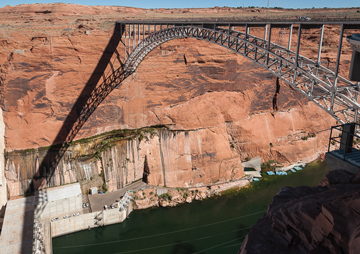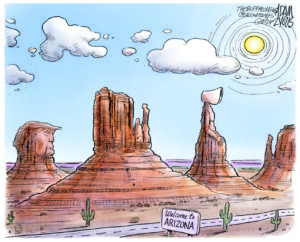How the Water Crisis in the West Renewed the Debate About the Effectiveness of Major Dams
In the midst of drought after drought, some are pushing for the enormous Glen Canyon Dam on the Colorado River to be decommissioned. Glen Canyon Dam is located in Page, Arizona. (Jacqueline Poggi / CC BY-NC-ND 2.0)
1
2
Glen Canyon Dam is located in Page, Arizona. (Jacqueline Poggi / CC BY-NC-ND 2.0)
1
2

Glen Canyon Dam is located in Page, Arizona. (Jacqueline Poggi / CC BY-NC-ND 2.0)
Wedged between Arizona and Utah, less than 20 miles up river from the Grand Canyon, a soaring concrete wall nearly the height of two football fields blocks the flow of the Colorado River. There, at Glen Canyon Dam, the river is turned back on itself, drowning more than 200 miles of plasma-red gorges and replacing the Colorado’s free-spirited rapids with an immense lake of flat, still water called Lake Powell, the nation’s second largest reserve.
When Glen Canyon Dam was built — in the middle of the last century — giant dams were championed as a silver bullet promising to elevate the American West above its greatest handicap — a perennial shortage of water. These monolithic wonders of engineering would bring wild rivers to heel, produce cheap, clean power, and stockpile water necessary to grow a thriving economy in the middle of the desert. And because they were often remotely located they were rarely questioned.
We built the Hoover Dam, creating Lake Mead, Glen Canyon Dam and more than 300 other dams and reservoirs at a cost of more than $100 billion. Such was the nation’s enthusiasm for capturing its water that even the lower part of the Grand Canyon seemed, for a time, worth flooding. Two more towering walls of concrete were proposed there, and would have backed up water well into the nation’s most famous national park.
But today, there are signs that the promise of the great dam has run its course.
Climate change is fundamentally altering the environment, making the West hotter and drier. There is less water to store, and few remaining good sites for new dams.
Many of the existing dams, meanwhile, have proven far less efficient — and less effective — than their champions had hoped. They have altered ecosystems and disrupted fisheries. They have left taxpayers saddled with debt.
And, in what is perhaps the most egregious failure for a system intended to conserve water, many of them lose hundreds of billions of gallons of precious water each year to evaporation and, sometimes, to leakage underground. These losses increasingly undercut the longstanding benefits of damming big rivers like the Colorado, and may now be making the West’s water crisis worse.
In no place is this lesson more acute than at Glen Canyon.
And yet even as these consequences come into focus, four states on the Colorado River are developing plans to build new dams and river diversions in an effort to seize a larger share of dwindling water supplies for themselves before that water flows downstream.
The projects, coupled with perhaps the most severe water shortages the region has ever seen, have reignited a debate about whether 20th century solutions can address the challenges of an epochal 21st century drought, with a growing chorus of prominent former officials saying the plans fly in the face of a new climate reality.
“The Colorado River system is changing rapidly,” says Daniel Beard, a former commissioner of the U.S. Bureau of Reclamation, which oversees all of the federal government’s dams in the West. “We have a responsibility to reassess the fundamental precepts of how we have managed the river.”
That reassessment — Beard and others say — demands that even as new projects are debated, it’s time to decommission one of the grandest dams of them all, Glen Canyon.
Glen Canyon Dam was erected as a political and environmental compromise, an evolution of the earliest water wars on the Colorado River.
In 1922 seven states — California, Arizona, Nevada, New Mexico, Utah, Colorado and Wyoming — signed a compact agreement dividing the Colorado between them, and, later, with Mexico. The northern states agreed to send an annual quota of water downstream to California, Nevada and Arizona, and the dam building began. But the faster those states grew the more water they used, and by mid-century Colorado, Wyoming and the rest of the upper basin feared it was only a matter of time before the south laid claim to the entire river. The northern states sought their own mega-dam — one which could give them control over the flow of the river and provide a gate through which they could mete out exactly how much of it was sent downstream. Their political jockeying in Congress eventually won the promise that the federal government would build more dams in the north too.
In 1956 the Colorado River Storage Project Act paved the way for the construction of four more large power-generating dams in the upper basin of the Colorado River. In its planning, the federal Bureau of Reclamation had zeroed in on a dam site on a tributary in northwestern Colorado called the Green River. But the reservoir it proposed to create would submerge a tract of treasured, fossil-laden parkland called Dinosaur National Monument. Environmentalists, led by legendary Sierra Club executive director David Brower in one of the nation’s early epic conservation battles, fought passionately to preserve the monument.
All sides agreed instead to proceed at a remote spot in southern Utah called Glen Canyon, in a region far from highways, about 200 miles northeast of Las Vegas. Glen Canyon Dam would help normalize the erratic flows of the Colorado, and flood a no-man’s land of barren sandstone domes and inaccessible dendritic canyons — transforming them into a surreal oasis called Lake Powell.
Damming rivers this way is as old as civilization itself, stretching back some 8,000 years to the foothills of Mesopotamia. From the start, the idea was to stem the risk of devastating floods by creating a catchment for the unpredictable torrents that rattle down from upstream. Once a river was restrained, its domesticated waters could be guided through ditches and canals to irrigate land for agriculture, and to use the force of gravity to power its delivery over great distances. For desert regions that got little rain, but watch seasonal snowmelt sluice by during the spring rush, dams became a way to capture that water and hold it until the time of year it was needed most.
With time, dams were developed especially for their ability to generate power. And since force is not just a function of the amount of water flowing, but of the mass of water held behind the dam, the dams grew broader. In 1942 the Bureau of Reclamation completed the low-slung Grand Coulee dam, a butchy mass of concrete more massive than the Pyramid at Giza, stretching for nearly a mile across Washington’s Columbia River. It is still today the single largest hydropower producer in the country.
Glen Canyon Dam is of a different sort — a tall, elegant, sweeping structure engineered in an arch bowing against the pressure of the water, enabling a relatively thin sheet of concrete to withstand unfathomable forces behind it. Arch dams like these were perfectly suited for the Colorado’s narrow chasms, and Glen Canyon — like the Hoover Dam — created a reservoir so deep that the sheer height of the water behind it promised to generate enormous currents of power. By all measures, its completion was a feat.
But it took 17 years for the reservoir to fill, and just 19 years after that, it began a steady decline. Today its potential has been severely undercut by its own inefficiencies. Thanks to the steady overuse of the Colorado River system — which provides water to one in eight Americans and supports one seventh of the nation’s crops — Lake Powell has been drained to less than half of its capacity as less water has flowed into it than has been routinely taken out. That relative puddle is no longer capable of generating the amount of power the dam’s builders originally planned, and so the power has become more expensive for the government to deliver, with the burden increasingly falling on the nation’s taxpayers. Since the dam’s power sales are relied on to pay for the operations of other smaller dams and reservoirs used for irrigation in the West, as Glen Canyon financially crumbles, so might the system that depends on it.
But it’s not just the reservoir’s overuse that is causing it to drain, it’s the very site and concept chosen for Lake Powell itself: the reservoir loses an extraordinary amount of its precious water. When a dam is built in the desert, its water is spread over a wide area under hot sun and wind, leading to massive evaporation. More than 160 billion gallons of water evaporate off of Lake Powell’s surface every year, enough to lower the reservoir by four inches each month. Another 120 billion gallons are believed to leak out of the bottom of the canyon into fissures in the earth, — a loss that if tallied up over the life of the dam amounts to more than a year’s flow of the entire Colorado River. According to the environmental group Colorado Riverkeeper, if the lost water were sold, it would generate some $350 million each year.
Cumulatively these debits, Beard says, amount to “the largest loss of water on the Colorado River,” — an amount equal to six percent of its total flow and enough to supply some nine million people each year.
Not every dam site shares Glen Canyon’s problems. Each dam serves a unique purpose — whether it’s power generation or water storage — and every region has different needs.
But Glen Canyon is far from the only project to fall out of favor — major projects are being decommissioned or reevaluated across the country. In some places there isn’t enough water to justify the environmental and economic costs of blocking a river. In others the dams have turned out to block the flow of sediment, stop fish migration, or threaten endangered species in ways that weren’t anticipated in the middle of the last century.
The Hoover Dam’s Lake Mead, which Wednesday fell to its lowest level ever, 145 feet below capacity, also loses hundreds of billions of gallons of water to evaporation and is just 37 percent full. The reservoir behind Arizona’s Coolidge Dam, one of the first major projects in Western water development and one of Arizona’s largest reservoirs, is virtually empty.
And dams are coming down. Six Western dams were deconstructed in 2015 alone. Just last month California and Oregon agreed to dismantle four more power-generating dams on the Klamath River, having realized that the facilities were crippling native salmon fisheries, which also have enormous economic value. “This is a good exercise of humankind correcting some of the mistakes that it’s made in the past,” California Gov. Jerry Brown said when announcing the plan. And in early May a federal judge in Oregon ruled that — because of extensive ecological damage — the system of dams on the Snake and Columbia Rivers “cries out for a major overhaul.”
Still, on the Colorado, today’s water managers refute the notion that it’s time for a change.
Glen Canyon Dam may be past its prime, says Michael Connor, the deputy secretary of the Interior and a former Commissioner of Reclamation, but its not past its usefulness. Though he calls the amount of water lost to evaporation and leakage “incredibly significant,” Connor credits Glen Canyon with numbing the pain of the recent drought. “Look at the last 15 years,” he says. “It’s the lowest inflow in history and there’s been no shortages on the Colorado River and that’s because of Glen Canyon Dam and Lake Powell and Hoover Dam and Lake Mead.”
There is also a political tide to be reckoned with; the delicate peace struck between the seven competing states and Mexico — and the fear that they’d never again be able to reach an agreement the likes of which they all signed in 1922. “Getting rid of Lake Powell… it would basically make the compact stand on its head,” said Bronson Mack, a spokesman for the Southern Nevada Water Authority in Las Vegas, pointing to the role that Lake Powell plays in guaranteeing the northern states have enough water to deliver to Nevada and the south each year. “We’ve always said cracking open the compact is going to land seven states in decades of litigation, so there has not been an appetite for it.”
Decommissioning Glen Canyon Dam, however, could offer a solution that politicians cannot afford to ignore — a cheap, immediate, and significant new source of water where it is most desperately needed.
Your support matters…Independent journalism is under threat and overshadowed by heavily funded mainstream media.
You can help level the playing field. Become a member.
Your tax-deductible contribution keeps us digging beneath the headlines to give you thought-provoking, investigative reporting and analysis that unearths what's really happening- without compromise.
Give today to support our courageous, independent journalists.






You need to be a supporter to comment.
There are currently no responses to this article.
Be the first to respond.